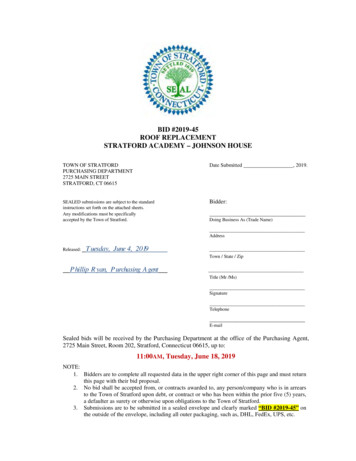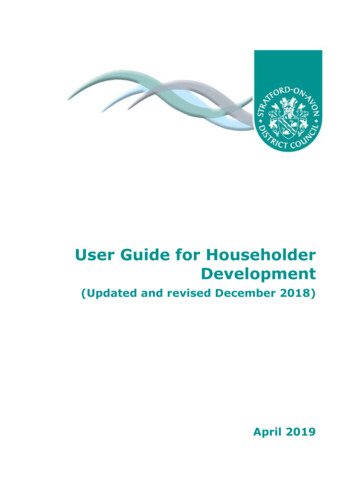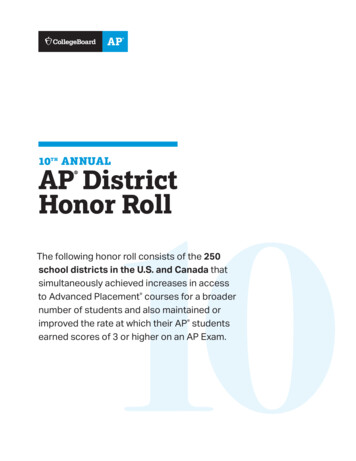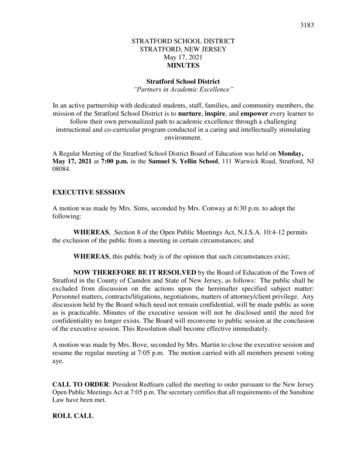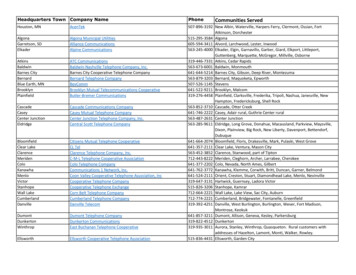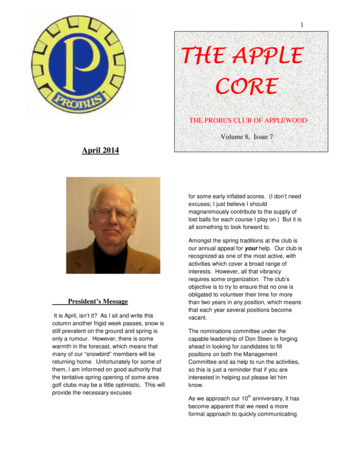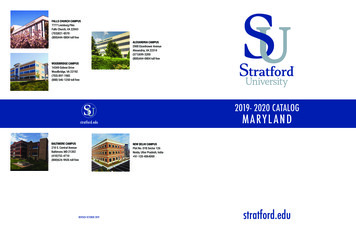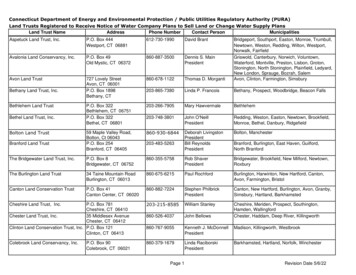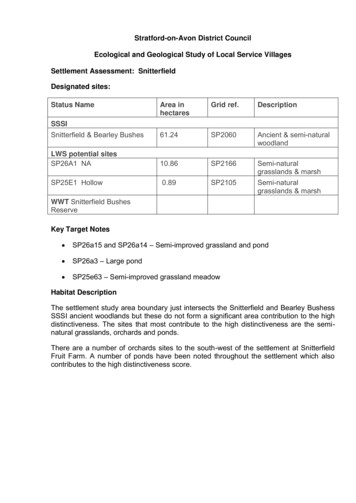
Transcription
Stratford-on-Avon District CouncilEcological and Geological Study of Local Service VillagesSettlement Assessment: SnitterfieldDesignated sites:Status NameArea inhectaresGrid ref.DescriptionSnitterfield & Bearley Bushes61.24SP2060Ancient & semi-naturalwoodlandLWS potential sitesSP26A1 NA10.86SP2166Semi-naturalgrasslands & marshSP25E1 Hollow0.89SP2105Semi-naturalgrasslands & marshSSSIWWT Snitterfield BushesReserveKey Target Notes SP26a15 and SP26a14 – Semi-improved grassland and pond SP26a3 – Large pond SP25e63 – Semi-improved grassland meadowHabitat DescriptionThe settlement study area boundary just intersects the Snitterfield and Bearley BushessSSSI ancient woodlands but these do not form a significant area contribution to the highdistinctiveness. The sites that most contribute to the high distinctiveness are the seminatural grasslands, orchards and ponds.There are a number of orchards sites to the south-west of the settlement at SnitterfieldFruit Farm. A number of ponds have been noted throughout the settlement which alsocontributes to the high distinctiveness score.
Distinctiveness Phase 1habitatsNo. of .866399Sub TotalModerateA112 Broad-leavedplantationA21 Dense/continuousscrubB6 Semi-improved neutralgrasslandJ113 Set-aside5132.07153138.902640.748815.371635.183Sub TotalLowA122 ConiferousplantationA132 Mixed plantationB4 Improved grasslandC31 Tall ruderalJ11 ArableJ12 Amenity .7512.40135882152Sub Total124359.01154Totals203421.27360HighA111 Broad-leaved seminatural woodlandA5 Orchard (commercial)B22 Semi-improvedneutral grasslandF1 SwampG1 Standing waterG2 Running water
Geological DescriptionSnitterfield has considerable potential for its Triassic geology (Mercia Mudstone Group),and overlying Quaternary deposits. Any excavations into natural geology would be ofpotential interest for purposes of recording and/or museum collecting.Protected SpeciesVeteran oak trees, hedgehog, smooth newt, white-letter hairstreak butterfly and harvestmouse with bat species of pipistrelle and brown long-eared plus the rare plant of hairydowny-rose have been recorded in the settlement area. In the wider area there areadditional records of great crested newt, grass snake, slow-worm, badger, barn owl,black poplar with additional bat records of noctule, common and soprano pipistrelles,whiskered/brandts, and an bat indeterminate species sp., common and sopranopipistrelle plus butterfly records of small heath, white admiral, grizzled skipper, dingyskipper, white-letter hairstreak and purple emperor. There are also rare plants includingherb paris, marsh willowherb, harsh downy-rose, greater plantain ssp., long stalkedcranesbill, round leaved cranesbill, meadow saffron, trailing tormentil, an eyebright, flyorchid, fools parsley ssp., wild daffodil, wild pansy and common spike-rush spp. and wildpear in the wider area.Recommendations for Further Survey Area behind the houses at Church road mix of open grassland, woodland andponds. Potential local wildlife site reference SP26A1
Stratford-on-Avon District Council Ecological Villages StudyTarget NotesSnitterfieldsp25e14Neglected grassland dominated by Arrhenatherum elatius; Dactylis glomerata and Holcus lanatuswith frequent Elytrigia repens; nettle; creeping thistle; broad-leaved dock and occasional Festucarubra and Poa trivialis.sp25e15Neglected grassland dominated by Arrhenatherum elatius; Dactylis glomerata and Holcus lanatuswith frequent Elytrigia repens; nettle; creeping thistle; broad-leaved dock; cow parsley; hogweedand occasional Festuca rubra; Poa trivialis; wild carrot; black knapweed and horse radish.UPDATED30/03/2012 by OP. Species poor, rough grassland with encroaching scrub.sp25e2Semi-improved field with Lolium perenne; Agrostis stolonifera; abundant creeping thistle; whiteclover; chickweed; knotgrass; hop trefoil; yarrow and greater plantain. The hedge boundary isthick with ash; oak; hazel and hawthorn trees and a thick understorey of bramble; elder and herbrobert.sp25e3Oak and ash woodland with a thick understorey of young ash and hazel. UPDATED 30/03/2012 byOP. No woodland at this location.sp25e5Poor semi-improved meadow with frequent Lolium perenne; Poa pratensis; Holcus lanatus andDactylis glomerata with occasional Agrostis tenuis; Festuca rubra and Phleum pratense. Forbsinclude frequent red clover; black knapweed and occasional ribwort plantain. There is scatteredbroad-leaved dock and bramble and dog rose scrub with some elm suckers.SP25E61Heavily grazed poor semi-improved grassland with pronounced ridge and furrow and three largeveteran oak trees.SP25E62Eastern part of this field is not an orchard, but contains very dense bramble. An abundance of birdlife. Inaccessible patch of grassland at its centre.SP25E63Steep sided field with semi-improved grassland on ridge and furrow. Common chickweed, lady'sbedstraw, creeping cinquefoil, meadow foxtail, ribwort plantain, creeping buttercup, yarrow,cowslip. A number of anthills.SP25E64Tall unmanaged species rich hedgerow with trees on a steep bank, next to running water. Speciesinclude hawthorn, blackthorn, oak, ash, hazel, and holly.sp25j8Rough semi-improved grassland along the margins of an arable field dominated by Arrhenatherumelatius and Dactylis glomerata with frequent creeping thistle and nettle. There are scattered lime;ash; poplar and oak trees. UPDATED 02/04/2012 by OP. Area of field margin reduced in size, nowcovers south east corner only.sp25j9Well spaced broad-leaved plantation of poplar over improved grassland with occasional patches ofcreeping thistle and ragwort.sp26a1Poor semi-improved; recently mown hay meadow. Signs of Cynosuruscristatus; Holcus lanatus;Phleum pratense; Dactylis glomerata; Arrhenatherumelatius; Elytrigia repens; Agrostis spp. andAlopecurus pratensis. Forbinclude yarrow; common vetch; prickly lettuce; cleavers; ribwortplantain;birds-foot-trefoil; cat's-ear; selfheal; poppy; white dead nettle; whiteclover; and greenalkanet. Towards the eastern side there is a small broadleafplantation with conifers. The area ispredominantly oak and ash with somesycamore; holly; sitka spruce; apple; silver birch; fieldmaple; dogwood; horsechestnut and wild service tree.sp26a10Semi-improved field with Lolium perenne; Agrostis stolonifera; abundantcreeping thistle; whiteclover; chickweed; knotgrass; hop trefoil; yarrow andgreater plantain. The hedge boundary is thickwith ash; oak; hazel and hawthorntrees and a thick understorey of bramble; elder and herb robert.sp26a11Amenity grassland with thick hedgerow boundaries containing ash; fieldmaple; holly; hawthorn;elder; dog rose; blackthorn; sycamore; ivy; bramble;white bryony; abundant black bryony andgreen alkanet.HABITAT BIODIVERSITY AUDITWarwickshire Historic and Natural EnvironmentBarrack Street, Warwick CV34 4THEmail: HBA@warwickshire.gov.uk22 June 2012
Target Notessp26a12Arable field of wheat; recently cut; but with locally abundant fieldpansy and wild pansy near theroad.sp26a13Large pond forming part of a garden; to which access could not be gained. From the road it waspossible to see that the pond was surrounded by greaterwillowherb; mayweed; nettle; prickly sowthistle and abundant cleavers. Itcontains Typha latifolia and is over-looked by mature oak; ashand sycamoretrees.sp26a14A green lane adjacent to a stream. Laid hawthorn hedge also includes ash; bramble; white bryony;dogwood and herb robert. The south side of the streamis lined with mature pollarded willow andelder with abundant ivy.sp26a15Interesting semi-improved grassland with recently dug pond and island. This has been created bydamming the stream which flows through the field. Inthe south west corner of the field is a largearea of meadowsweet. Grassesinclude Dactylis glomerata; Lolium perenne; Alopecurus pratensis;Holcuslanatus; Arrhenatherum elatius; Cynosurus cristatus and Agrostis stolonifera.Schoenoplectus lacustris have been planted around the pond edge. Forbs includeshepherd'spurse; creeping thistle; greater willow herb; prickly sow thistle;greater knapweed; pineappleweed; scented may-weed; bird's-foot-trefoil; commonvetch; knotgrass; redshank; prickly lettuce;lesser stitchwort; red and whiteclover and chicory . There are two bee hives on the south east sideof thefield. The boundary is predominantly made up of trees; including cherry;hawthorn; elder;ash; field maple; hazel and alder.sp26a16Area of trees including mature and regenerating grey poplar; with anunderstorey of dogwood;wayfaring; blackthorn and dog rose.sp26a17Field of poor semi-improved grassland; containing abundant greaterplantain; dock; creepingthistle; common sorrel; occasional knotgrass;shepherd's purse; nettle; red and white clover anddandelion. Grasses includeDactylis glomerata and Lolium perenne.sp26a19Oak and ash woodland with a thick understory of young ash and hazel. UPDATED 29/03/2012 byOP. No woodland at this location.sp26a2Hedgerow to the east with elder; ash; ivy; hawthorn; field maple; dogwoodand bramble allpresent.SP26A22St. James the great churchyard. Semi-improved grassland which is mown but not too intensively.Contains abundant primrose, lesser celendine, ground ivy, common dog violet, amongst a numberof garden plants.sp26a3Large pond with willow; beech and ash surrounding it. Mixture of aquaticplants; including waterlily; greater willowherb; water forget-me- not;amphibious bistort; brook lime; water plantain;gypsy-wort; Schoenoplectuslacustris; marsh willow-herb; giant bittercress; great yellow-cressandbog-bean; with heavy blanket-weed cover in open areas. Coots; moorhen;mallards and heronseen. The hedge between the pond and field is largely madeup of ornamental species as well assome hawthorn and bramble.sp26a4Poor semi-improved field with Lolium perenne; Holcus lanatus; Phleumpratense; Agrostiscapillaris; Dactylis glomerata; self heal; chickweed;bird's-foot-trefoil; red and white clover.Brimstone butterfly were seen here. The field has very good ridge and furrow grade 2/3; which arequite curved;extending to the full length of the field. UPDATED 29/03/2012 by OP. Pronouncedridge and furrow, however the field is rough cattle pasture improved grassland.sp26a5Hedge row on the north side of the road with black bryony; elder; bramble;horse chestnutstandards; hawthorn; alder; English elm; dog rose; honeysuckle;ivy; meadowsweet; ash andwayfaring tree. The south side is similar incomposition but with more standards of oak and ash.Frequent gate-keeperbutterflies.sp26a6Unmown roadside strip. Approximately 5m wide with Phleum pratense; Holcusmollis; bramble;thistle; sorrel and yarrow.sp26a7Strip of five metres wide unmown by the hedge with dock; spear-thistle;common sorrel; yarrow;bramble; Holcus mollis and Phleum pratense.HABITAT BIODIVERSITY AUDITWarwickshire Historic and Natural EnvironmentBarrack Street, Warwick CV34 4THEmail: HBA@warwickshire.gov.uk22 June 2012
Target Notessp26a8Road side fence with white bryony; common toadflax and bittersweet growingon and over it.sp26a9Amenity area with species rich hedge. Contains ash; field maple; holly;ivy; bramble; hawthorn;elder; dog rose; blackthorn and sycamore. Alsocontains abundant black bryony and some whitebryony with green alkanetfrequent along base of hedge.sp26f13A series of improved fields that have recently been planted up by broadleaf trees. A number ofskylark aresp26f15Farm pond dominated by Glyceria fluitans; Juncus effusus and creeping buttercup. HawthornpartlySP26F38Neglected grassland with a small pond and bramble throughout.HABITAT BIODIVERSITY AUDITWarwickshire Historic and Natural EnvironmentBarrack Street, Warwick CV34 4THEmail: HBA@warwickshire.gov.uk22 June 2012
plantation 13 8.90 26 A21 Dense/continuous scrub 4 0.74 8 B6 Semi-improved neutral grassland 8 15.37 16 J113 Set-aside 3 5.18 3 Sub Total 28 30.19 53 Low A122 Coniferous plantation 2 0.12 2 A132 Mixed plantation 13 7.00 13 B4 Improved grassland 58 14
